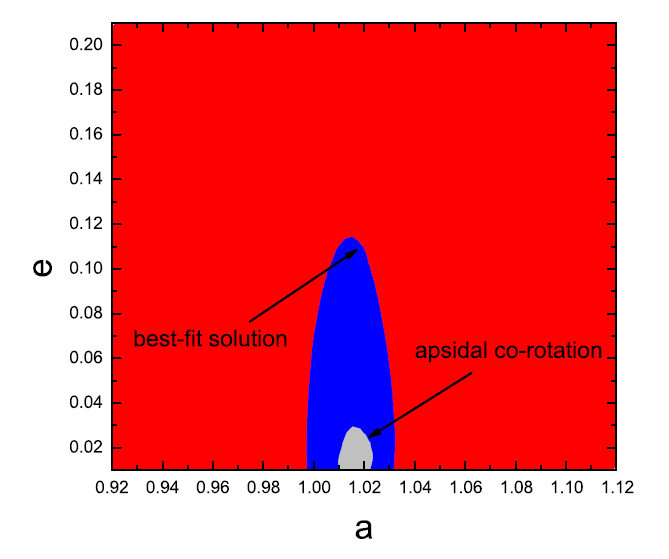The recently discovered system HD 15538 is a famous extrasolar planetary system because of its poor metallicity. Dynamical analysis of the previously reported orbits reveals that the two planets were likely trapped in a 2:1 MMR.With this, it is natural for us to use this system to examine the theoretical result that the two planets should be in apsidal co-rotation after an adiabatic migration (Beauge et al., 2003, 2006). Our simulations suggest that: (1) The two planets are not in an apsidal co-rotation for the previously reported best-fit orbit parameters. However, if the eccentricity of the outer planet takes value very close to the lower limit of itsconfidence interval, apsidal co-rotation could be expected. Thus, we think that the globally minimizing solution could be missed in the previous orbital determination. Using an efficient global optimization method, a better solution is found, for which is reduced from 1.4 to 1.2 (nearly 15 percent lower). Our best-fit solution is significantly different from the previously reported one. In particular, the eccentricity of the outer planet is much smaller than before, and the possibility of the 2:1 MMR is increased. However, the possibility that the two planets trapped in a 2:1 MMR with apsidal co-rotation is still not high. (2) Following the previous studies, we performed a set of simulations of the adiabatic convergent migration process. The results confirm the theory of Beauge et al. for systems like HD 155358, that is, they can be formed with simultaneous 2:1 MMR and apsidal co-rotation from a reasonable adiabatic planetary migration. In other words, if the considered system had suffered a planetary migration process, the 2:1 MMR is the reasonable result of such migration. And if the migration is adiabatic, the two planets will be in apsidal co-rotation. The results consistently indicate that the 2:1 MMR forms before apsidal co-rotation. This implies that the possibility of the 2:1 MMR without apsidal co-rotation could be a consequence of an appropriate life time of the protoplanetary disk. (3) The long-term stability of the formed system and of its resonant structure are extensively explored. The simulation results show that the lower eccentricity orbits are often more stable, and the 2:1 MMR with apsidal co-rotation can be kept longer if the eccentricity of the outer planet is less than 0.03. However, the apsidal co-rotation doesn't frequently occur in the real known systems. We think two reasons could be responsible for this. One is that the spectroscopic orbits of known systems are not reliably determined. The other is that the migration is not adiabatic or the disk disappear before an adiabatic co-rotation is formed. 
By with MA Dazhu
Fig. 1. The resonant structure stability analysis for the HD 155358 system in (a, e) space. Here, grey, blue and red represent the 2:1 MMR with apsidal co-rotation, the 2:1 MMR without apsidal corotation and non-resonance, respectively.
The research work by Ma Da-Zhu et al., has been published in Monthly Notices of the Royal Astronomical Society (MNRAS (2017)470: 706-712.). For more details please see: https://doi.org/10.1093/mnras/stx1230 |
